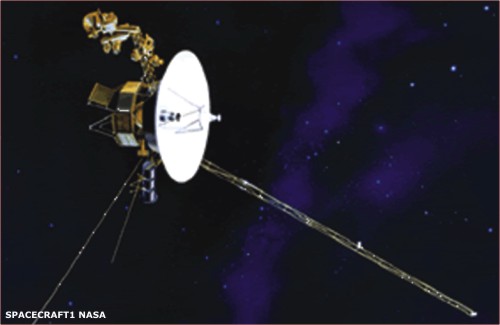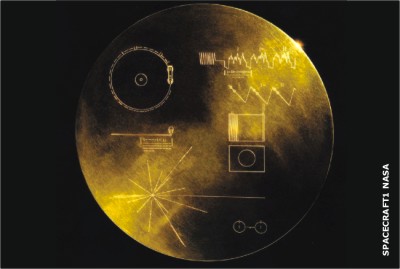
Inside
|
SCIENCE FORUM "Is Anyone Out There?" Earth Calling Interstellar Space, In 55 Languages
Hello! Let there be peace everywhere…
A mission that was supposed to last just five years celebrated its 30th anniversary last month. Voyager 1 was launched on September 5, 1977, and Voyager 2 just weeks before. Thirty years after blasting off on a journey that would rewrite our knowledge of the solar system, Nasa's two venerable Voyager spacecraft are escaping the influence of our sun and approaching interstellar space, while humankind continues to reap the benefits of three decades of discovery. Both Voyager spacecrafts carry messages and greetings to intelligent extraterrestrial life, should it be encountered. The message is carried by a phonograph record, a 12-inch gold-plated copper disk containing sounds and images selected to portray the diversity of life and culture on Earth. The contents of the record were selected for Nasa by a committee chaired by Carl Sagan. Dr. Sagan and his associates assembled 115 images and a variety of natural sounds. To this they added musical selections from different cultures and eras, and spoken greetings from Earth-people in fifty-five languages. Scientists continue to receive data from the Voyager 1 and 2 spacecraft as they approach interstellar space. The twin craft have become a fixture of popular culture, inspiring novels and playing a central role in television shows, music videos, songs and movies from the 1980s and 1990s. Many of these fictional works focus on what would happen if an alien race were able to locate Earth via Voyager's famous golden records. Between them, Voyager 1 and 2 have explored all the giant planets of our outer solar system: Jupiter, Saturn, Uranus, Neptune, 48 of their moons, and the unique system of rings and magnetic fields. Both spacecraft continue to send home information daily as they sail their way into interstellar space. The Voyagers have returned more new knowledge about the outer planets than had existed in all of the preceding history of astronomy and planetary science. The Voyagers 1 and 2 will be the third and fourth human spacecraft to fly beyond all the planets in our solar system. Pioneers 10 and 11 preceded the Voyager spacecraft beyond the solar system by outstripping the gravitational attraction of the Sun. But on February 17, 1998, Voyager 1 passed Pioneer 10 to become the most distant human-made object in space. The plaques carried by Pioneer and the Voyager golden records have a few things in common. Both were co-designed by Carl Sagan. Both were indirect and symbolic attempts to communicate with extraterrestrials: interstellar 'messages in a bottle'. Both contain cryptic information that is not language-specific, so it can be decoded and understood by advanced ETs (but not the average earth-dweller). The cover of the Voyager golden record show a number of diagrams, including instructions on how to play the record (the needle was on board the spacecraft) and how to decode the video, a sun-pulsar diagram and a representation of the hyperfine transition of elemental hydrogen that will help the extraterrestrials decode the other diagrams. The sounds and images of Earth include information about every continent on the planet, as well as Earth's location in space. From diagrams of the human anatomy to leaping dolphins; from Bushmen hunters to Balinese dancers; from a page of Newton's System of the World to an astronaut in space; the images portray the history and culture of people and other species of Earth. They include photographs of the Taj Mahal, a street scene in Pakistan and rush hour traffic in India! The musical selections include the traditional such as Azerbaijani bagpipe music, a Navajo Indian night chant, and a Zairian Pygmy girls' initiation song; as well as popular music such as Melancholy Blues performed by Louis Armstrong; and classical music such as India raga (Jaat Kahan Ho) and excerpts from Mozart's The Magic Flute and Beethoven's Fifth Symphony. Because of Voyager's launch schedule, there was not a lot of time to assemble the recorded greetings. Nasa asked Dr Sagan, then at Cornell University, to assemble the messages and gave him the freedom to choose the format and what would be included. Unfortunately, not much information is available about the individual speakers. They were given no instructions on what to say other than that it was to be a greeting to possible extraterrestrials and that it must be brief!
A selection from the recorded messages in 55 languages (some of them extinct) include: Amoy :Friends of space, how are you all? Have you eaten yet? Come visit us if you have time. This month also marks the 50th anniversary of the launch of Sputnik, the first satellite to go into space and change the world forever. October 4, 1957, was the start of the space race. Fifty years after Sputnik's launch, nearly 1000 satellites now orbit the Earth, providing a wide range of applications from communications to weather observation. *Images and selected text from Nasa's Jet Propulsion Laboratory, California Institute of Technology. Rashida Ahmad is Contributing Ecitor, Forum. Paper solution for future power Rubik's Cube solved in 26 moves Oldest life on Earth |




